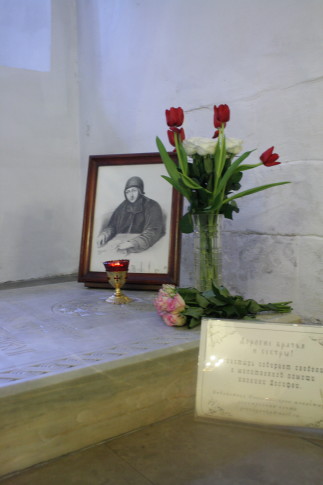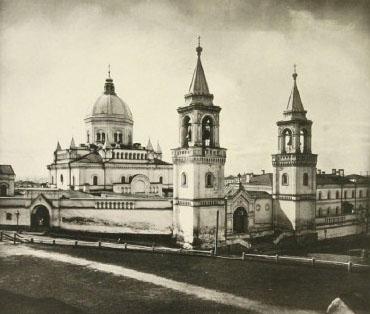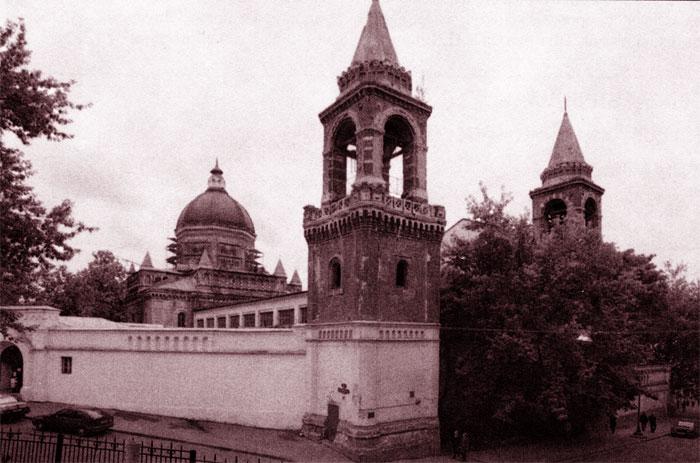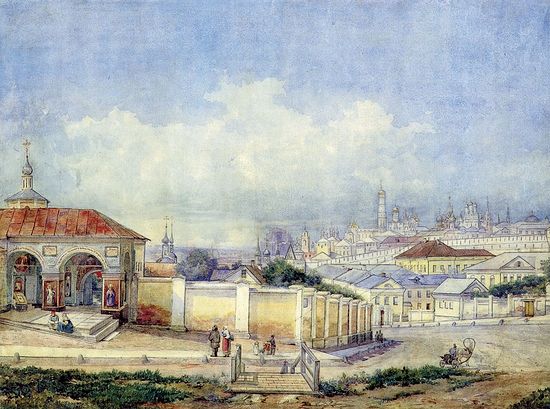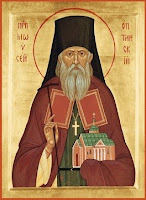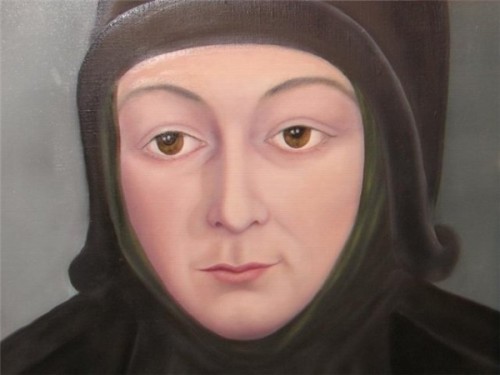
Nun Dosifea, 1746 - 1810, unknown artist. The only color picture of which I am aware, and probably the only close up. One can get a sense of her personality far better than the black and white depiction pictured in the earlier post at her tomb at Novospassky Monastery, Moscow
Below is Part I of a thoughtful essay by the nun Elyria Kharchenko about the life of this intriguing ascetic. Unfortunately, the internet translation is far from perfect, but one can get the sense of the story. I made a few edits.
This part takes the Princess from birth to entry into the St John the Forerunner Convent in Moscow
"Reliable historical information about the origin of the famous Moscow-aged women recluse, runneth quarter of a century in the Ivanovo monastery there. No documents, no direct and precise evidence, remains a legend, but it is quite significant. But the thing that really elevates her personality - this ascetic life.
Indirect evidence suggests it a noble and highest origin and live in direct and precise evidence of the Decree of her life in seclusion, her gifts of comfort, prayer and vision. For us it is important and valuable is what the nun was carrying Dosifeya hard shutter cross, and then helped many, many people.
With deep humility, she accepted the abrupt change of their own destiny and lead a life of prayer and fasting according to the monastic vows. According to the clerk of the monastery and Moscow merchant FN Shepeleva, bayou Dosifeya was of medium height, thin, but kept on his face "features former beauty; its methods and the treatment showed the nobility of its origin and education. " Glikeriya Golovin, who studied in a monastery in one of the nuns told me that of all the nuns Dosifeya allowed himself to only one nun, "but her only Abbess but her confessor, and did not go anywhere, even in a general monastery church." Staritsa visited only the temple gate of the Kazan Icon of the Theotokos. The service made her confessor with prichetnikom. In church she "came out very rarely and then accompanied her to the oversight old women. Then the church doors were locked from the inside, so no one could get to the window ... her curtains drawn, sometimes curiosity and fame attracted people, but full-time minister, takes the place of the guard, drove away the curious, "- said IM Snegirev. On the contents of her to let go of a particular amount from the Treasury; table she could have if she wanted, always good. The absence of the name of hermit monks in the statements of that time proves that the content of its special instructions have been made. Was she Princess Tarakanov?
Quite often in the historical and fiction are confused and mixed two faces: camozvanku, called himself "Princess of Vladimir," the daughter of the Empress Elizabeth , and Princess Augusta Tarakanov, the future nun-recluse. The picture from the Tretyakov Gallery "Princess Tarakanov in the fortress during the flood," everyone knows. However, few people know that the heroine of the paintings of Konstantin Flavitsky died two years before the flood depicted. And it is very few people know that the impostor posing as the daughter of the Empress Elizabeth, never called herself Tarakanova. Picture Flavitsky nothing more than a romantic fiction of the artist, far removed from reality.
On the fate of the princess amazing Tarakanova tells historical tradition. It binds her family ties with the royal family and the story of a secret, but the law morganatic marriage of Empress Elizabeth with Count Alexei Razumovsky (1709-1771). The wedding took place in Moscow's Cathedral of the Resurrection in Barash (str. Pokrovka, 26/1) in June 1744 in the other sources referred to the suburban village of Perov, where the marriage was concluded November 24, 1742. Researcher a kind Countess MA Razumovskaya writes that in Moscow church in Pokrovka was served thanksgiving service after the wedding. Whatever it was, the marriage was made in secret, but in front of witnesses, and Count Razumovsky were presented the documents testifying about his marriage.
After marriage with Count Empress moved to St. Petersburg, Razumovsky settled in an apartment adjacent to the queen's apartments. In the capital, Empress built for him in 1748 a special palace, now known under the name of the Anichkov. Razumovsky came from a simple Cossacks; built in the count's dignity of the court choristers, he retained the simplicity and popular religiosity. In 1756 Empress bestowed his wife the title of Field Marshal, although to military Earl had nothing. Expressing his gratitude to the Empress, Alexey G., however, conscious of his humble origins, did not seek to interfere in politics and fight the court parties. Only two issues of the graph is always firmly and publicly filed your voice without fear of boring his Empress petitions - is a request for the clergy and for his native Ruthenia, which Empress Elizabeth personally visited in the summer and autumn of 1744. For a long time she lived in the house in the Razumovsky Kozeltse city and met there with all the relatives.
"I do not know another family who, having been in such excellent mercy of the court, - wrote in his memoirs, the Empress Catherine II of Razumovsky, - would be so loved by all as the two brothers." After ascending the throne, Catherine II sent to the Chancellor Razumovsky MI Vorontsov with a decree in which he was given the title of Highness as the legitimate wife of the late Empress. Razumovsky took from a secret casket marriage documents, read them the Chancellor and then threw in topivshiysya fireplace, adding: "I was nothing more than a faithful servant of her Majesty the late Empress Elizabeth, showered me above my merit deeds ... Now, you see that I do not have any papers. " According to biographer Razumovsky AA Vasilchikova, Count Alexei G. "shun pride, hate and deceit, without any education, but gifted with the nature of the mind solid, was kind, forgiving, courteous in dealing with the younger, .... and enjoyed general love."
The daughter of Count Razumovsky and empress was born in late 1745 or early 1746. The girl was named Augusta in honor of the holy martyrs, whose memory takes place on 24 November. Augusta, brought up in high society, young years spent abroad and could not imagine their lives to monastic. Why she got the name Tarakanova - suggest that by distorted Daragan names. It is known that sister of Alexei Razumovsky was married to Colonel Little Russian troops EF Daraganom. Their children, Daragan (or, as they are otherwise called, Daraganovy), were brought to St. Petersburg and lived at the court; people unfamiliar name changed in consonance Tarakanov; perhaps Augustus child lived with his aunt Daragan in the Ukraine and in St. Petersburg, and thus, together with her children nicknamed Tarakanova. Whatever it was, but in August in the tradition and history of the name Tarakanova firmly established.
Princess in August raised abroad. Most if the mother, she was sent to her death or after December 25, 1761 the father of Count Razumovsky, - unknown; but of course, that she had lived there until the 1780s. AA Vasilchikov reports that Razumovsky really brought up abroad in Switzerland, his nephews Daraganov. There would, in Europe, in peace and contentment in August and would have finished his life, but the Poles affair ruined her happiness. Abroad we know who the Princess. The Poles have decided around 1773 to deliver the difficulty in the face of the Empress Catherine Elizabeth's daughter, the pretender to the Russian throne. August itself did not want to, but have found a front face - impostor, known in history as the "Princess of Vladimir". Many had trouble eating, a lot of money spent to produce confusion in Russia, make some as much trouble to Catherine; but the invention is not successful. "Princess Vladimir" in Italy, Leghorn raid, Count Alexei Grigorievich Orlov-Chesmensky was arrested, brought to St. Petersburg, imprisoned in the Peter and Paul Fortress and there December 4, 1775, died of tuberculosis. The point of it was kept in the strictest confidence: either in Russia or abroad, no one knew what happened to her. And since two years after its conclusion, it was in 1777, in St. Petersburg was a great flood, and the rumor spread that she drowned in a cell from which forgot or did not want to bring it.
Impostor posing as the daughter of the Empress Elizabeth, died, but the real Princess Tarakanov was alive and free. The idea that there is a daughter of the Empress that her name and birth may serve as a pretext for intrigue Poles or other enemies of Russia, Catherine was worried, and riot Pugachevsky recently deceased impostor, court intrigues and conspiracies have increased this concern. After all, in the XVIII century in Russia it was not the law of succession - it was the age of palace revolutions. Born a German princess, Catherine II ascended the Russian throne as a result of the coup and did not feel at ease.
She was taken to Moscow. The Empress is said to have talked to her for a long time, frankly, spoke about the recent riot Pugachev, about the Troubles fake, the Public shocks that may continue to be, if her name will take advantage of the enemies of the existing order, and finally announced that it is to Russia's peace of mind to retire from light to live in seclusion in a monastery and not to become a tool in the hands ambitious, take the veil. [The princess] listened to the verdict. Oppose the Empress was unthinkable.
By imperial order the princess was tonsured a nun with the name Dosifeya and kept for about 25 years a closely guarded gate. In the XVIII century in Russia ancient custom involuntary vows as a monk of persons guilty of dangerous or suspicious was still in full force. There were monasteries, in which the government brought order to the deep mystery of the noble persons, and sometimes humble origin; it passed under the supervision of their abbots and abbesses, tonsured or simply to close the cell. The reason for detention, and sometimes the names of their most carefully hidden; so sometimes they die there, no one finds out. So the monastery was in Moscow Women's St. John the Baptist, which is the Ivanovo hill near Solyanka street."
https://rusidea.org/25021701
[/color]
